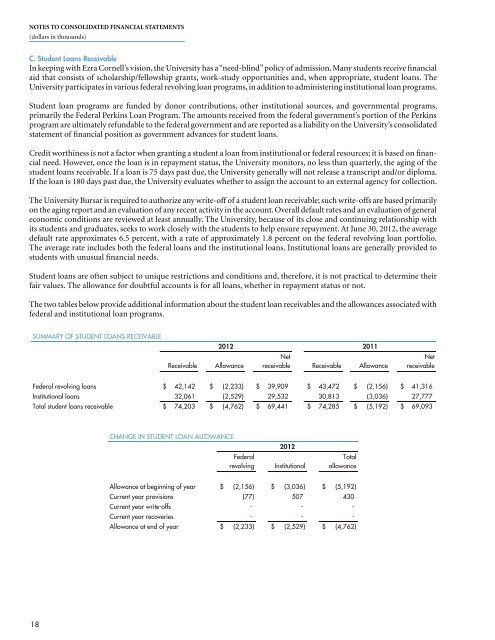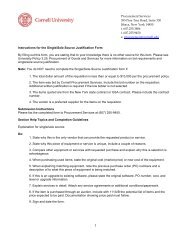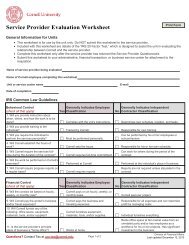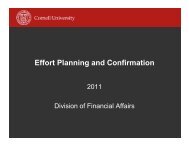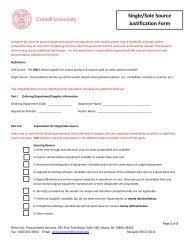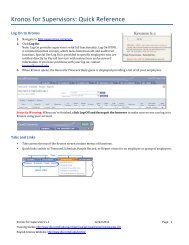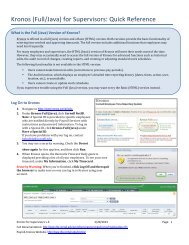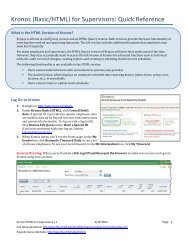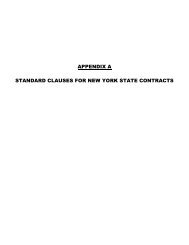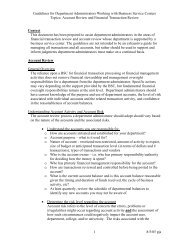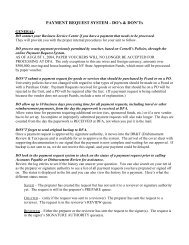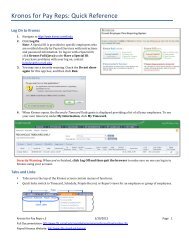NOTES TO CONSOLIDATED FINANCIAL STATEMENTS(dollars in thousands)C. Student Loans ReceivableIn keeping with Ezra <strong>Cornell</strong>’s vision, the <strong>University</strong> has a “need-blind” policy of admission. Many students receive financialaid that consists of scholarship/fellowship grants, work-study opportunities and, when appropriate, student loans. The<strong>University</strong> participates in various federal revolving loan programs, in addition to administering institutional loan programs.Student loan programs are funded by donor contributions, other institutional sources, and governmental programs,primarily the Federal Perkins Loan Program. The amounts received from the federal government’s portion of the Perkinsprogram are ultimately refundable to the federal government and are reported as a liability on the <strong>University</strong>’s consolidatedstatement of financial position as government advances for student loans.Credit worthiness is not a factor when granting a student a loan from institutional or federal resources; it is based on financialneed. However, once the loan is in repayment status, the <strong>University</strong> monitors, no less than quarterly, the aging of thestudent loans receivable. If a loan is 75 days past due, the <strong>University</strong> generally will not release a transcript and/or diploma.If the loan is 180 days past due, the <strong>University</strong> evaluates whether to assign the account to an external agency for collection.The <strong>University</strong> Bursar is required to authorize any write-off of a student loan receivable; such write-offs are based primarilyon the aging report and an evaluation of any recent activity in the account. Overall default rates and an evaluation of generaleconomic conditions are reviewed at least annually. The <strong>University</strong>, because of its close and continuing relationship withits students and graduates, seeks to work closely with the students to help ensure repayment. At June 30, <strong>2012</strong>, the averagedefault rate approximates 6.5 percent, with a rate of approximately 1.8 percent on the federal revolving loan portfolio.The average rate includes both the federal loans and the institutional loans. Institutional loans are generally provided tostudents with unusual financial needs.Student loans are often subject to unique restrictions and conditions and, therefore, it is not practical to determine theirfair values. The allowance for doubtful accounts is for all loans, whether in repayment status or not.The two tables below provide additional information about the student loan receivables and the allowances associated withfederal and institutional loan programs.SUMMARY OF STUDENT LOANS RECEIVABLEReceivable<strong>2012</strong> <strong>2011</strong>AllowanceNetreceivable Receivable AllowanceNetreceivableFederal revolving loans $ 42,142 $ (2,233) $ 39,909 $ 43,472 $ (2,156) $ 41,316Institutional loans 32,061 (2,529) 29,532 30,813 (3,036) 27,777Total student loans receivable $ 74,203 $ (4,762) $ 69,441 $ 74,285 $ (5,192) $ 69,093CHANGE IN STUDENT LOAN ALLOWANCEFederalrevolving<strong>2012</strong>InstitutionalTotalallowanceAllowance at beginning of year $ (2,156) $ (3,036) $ (5,192)Current year provisions (77) 507 430Current year write-offs - - -Current year recoveries - - -Allowance at end of year $ (2,233) $ (2,529) $ (4,762)18
NOTES TO CONSOLIDATED FINANCIAL STATEMENTS(dollars in thousands)3. INVESTMENTSA. General InformationThe <strong>University</strong>’s investments are overseen by the Investment Committee of the Board of Trustees. The <strong>University</strong>’s investmentstrategy incorporates a diversified asset allocation approach and maintains, within defined limits, exposure to themovements of the world equity, fixed income, commodities, real estate, and private equity markets. Based on guidelinesestablished by the Investment Committee, the <strong>University</strong>’s Investment Office directs the investment of endowment andtrust assets, certain working capital, and temporarily invested expendable funds.The <strong>University</strong> has categorized its investment assets in accordance with the fair-value measurement hierarchy. Thefollowing describes the hierarchy of inputs used to measure fair value; it also describes the primary valuation methodologiesused by the <strong>University</strong> for investment assets measured at fair value on a recurring basis.Fair value for Level 1 is based upon quoted prices in accessible active markets for identical assets. Market price data isgenerally obtained from exchange or dealer markets. The <strong>University</strong> does not adjust the quoted price for such assets.Fair value for Level 2 is based upon quoted prices for similar instruments in active markets, quoted prices for identicalor similar instruments in markets that are not active, and model-based valuation techniques for which all significantassumptions are observable in the market or can be corroborated by observable market data. Inputs are obtained fromvarious sources, including market participants, dealers, and brokers. In determining fair value of financial instruments,the <strong>University</strong> considers factors such as interest rate yield curves, duration of the instrument, and counterparty credit risk.The fair value of Level 2 instruments is determined using multiple valuation techniques including the market approach,income approach, or cost approach.Fair value for Level 3 is based upon valuation techniques that use significant inputs that are unobservable.Investments included in Level 3 consist primarily of the <strong>University</strong>’s ownership in alternative investments (principallylimited partnership interests in hedge, private equity, real estate, and other similar funds). The fair value of certain alternativeinvestments represents the ownership interest in the net asset value (NAV) of the respective partnership. The NAV ofthese investments is determined by the general partner, and is based upon appraisal or other estimates that require varyingdegrees of judgment. If no public market exists for the investment securities, the fair value is determined by the generalpartner taking into consideration, among other things, the cost of the securities, prices of recent significant placementsof securities of the same issuer, and subsequent developments concerning the companies to which the securities relate.The <strong>University</strong> has performed significant due diligence around these investments to ensure that NAV is an appropriatemeasure of fair value as of June 30.The <strong>University</strong> uses the NAV to determine the fair value of all alternative investments that do not have a readily determinablefair value and that have financial statements consistent with the measurement principles of an investment company or havethe attributes of an investment company. Investments that can be redeemed at NAV by the <strong>University</strong> on the measurementdate or in the near term, 90 days or less, are classified as Level 2. Investments that cannot be redeemed on the measurementdate or in the near term are classified as Level 3.The methods described above may produce a fair-value calculation that is not indicative of net realizable value or reflectiveof future fair values. Furthermore, while the <strong>University</strong> believes its valuation methods are appropriate and consistent withother market participants, the use of different methodologies or assumptions to determine the fair value of certain financialinstruments could result in a different estimate of fair value at the reporting date.19


